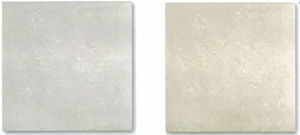Lawmakers Help Build Taiwan's Green Building Materials Industry
Green materials are labeled ecological, healthful, high-performance and recycled
2012/03/06 | By Ken LiuThe range of eco building materials available in Taiwan has risen over the past few years to include non-toxic electrical cables, parquet flooring, tiles, paints, carpets, adhesives, fillers, glass, cushion and gypsum boards.
The lawmakers in Taiwan are credited with pushing for eco-correct construction on the island. In November 2011, the legislature ratified a bill to impose stringent requirements on air quality inside houses to keep residents from inhaling hazardous particles such as carbon monoxide, volatile organic chemicals, formaldehyde, fungus, carbon dioxide, germs and ozone. Violators can be fined NT$50,000-250,000 (US$1,666-8,333) depending on magnitude of infraction.
Putting the issue into perspective, T.C. Chen, chairman of the Taiwan Green Building Material Council (TGBMC) that represents around 100 manufacturers islandwide, says: “A person typically spends 90% of lifetime indoors, so inhaling hazardous particles from building materials is more damaging to health than smoking cigarettes.”
Before the recent law with pecuniary penalty, on July 1, 2009 the government raised the minimum content of green building materials installed in buildings from 5% to 30%, with homebuilders found in violation denied a move-in permit.?
The Ministry of the Interior (MOI) issues the “Green Building Material Label” to material suppliers based on recommendations from the nonprofit Taiwan Architecture and Building Center (TABC), who evaluates suppliers' applications that are supported by test reports from government-approved laboratories.
Green building materials are labeled as four types: ecological, healthful, high-performance and recycled.?
According to TABC, the MOI issued 200 labels in the first 11 months of 2011, 70% more than issued in the same period of 2010, with 602 applications covering 5,134 products having passed examinations.
First Green Cable in Taiwan
Ta Ya Electric Wire & Cable Co., Ltd., founded in 1955 as one of Taiwan's biggest electrical cable and wire makers, has been drumming up business in the building materials market since winning the Environmental Protection Administration's (EPA) Green Mark in 2008 with its lead-free PVC wires and chlorine-free cables. “They do not produce dioxin when burnt,” stressed Jack Chao, a sales rep, as he pitched the non-toxic, recyclable cables and wires at a building materials trade show in late 2011 in Taipei.
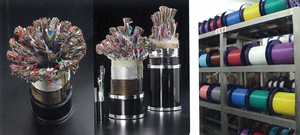
With the company claiming to be Taiwan's first cable & wire maker to introduce eco-friendly products that are sold under its “Green Inside” label, Chao emphasizes that the non-toxic cables and wires cost marginally more than traditional products, but the company does not price the products higher in hope of encouraging usage of the eco-friendly products.
Eco-friendly Flooring
A TGBMC member, Mosia Flooring Corp., is certified with MOI's Green Building Materials Label for healthful features. The company has developed at least three non-hazardous technologies to make building materials. Its sprayer captures VOCs to disintegrate into non-toxic H2O and CO2. Parquet flooring is made of bamboo with a three-year warranty, instead of solid wood, and with a patented lamination technique using thermoplastic polymer resin instead of urea formaldehyde resin.
SGS tests prove the sprayer captures 42% of VOCs in a cubic meter in 15 minutes, 88% in half an hour and totally in 60 minutes.
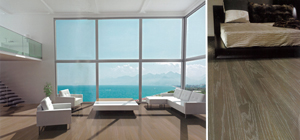
Mosia laminates flooring with resin and removes most of the VOCs at 200 degree Celsius and under high pressure, with tests showing 0.3 milligrams of formaldehyde in one liter of resin to meet the JIS A 5908 standard of Japan and CNS 1349 standard of Taiwan.
The company makes bamboo parquet flooring with locally-grown bamboo, reducing carbon footprint created by importing materials from abroad. “We do not use bamboo from China or Southeast Asia as do most of our domestic competitors. Taiwan-grown bamboo is of much better quality,” says Mosia sales rep Tim Teng, adding that bamboo matures rapidly to be more suitable than other trees that grow too slowly to be harvested for making parquet flooring.
Despite abundant bamboo on the island, the company uses the material efficiently. “The parquet is only 0.35mm thick and mounted on EPA foam that cushions and is also mold resistant; while bamboo flooring is durable, cool to touch in summer and warm in winter,” says Teng.
Faux-granite Paints
Taising Building Materials Co., Ltd. is another green certified supplier, specializing in paints which create texture and color of granite, with the VOC-free coatings made of various materials including cement, glass, metal, wood, and plastics.
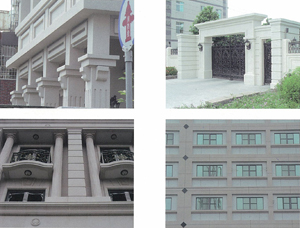
Resistant to high temperature, acid erosion, ultraviolet rays, water seepage, mold, static, wear and tear and discoloring, the paints also do not flake and firmly adheres to walls.
Another eco-friendly feature of the paints is increased resin and lower mineral content. The company's formula shows the resin to account for 85%, surging from 5% in the old formula, with mineral content dropping to only 5% from 70%. “Minimal mineral content means less exploitation of stone resources to lessen eco-damage. Besides, mainland Chinese authorities have recently stipulated to minimize building materials to achieve lightweight and safety, hence promoting lighter materials,” says a sales rep.
Low-formaldehyde Flooring
Kending Enterprises Co., Ltd. has a Healthy Green Building Materials Label for its low formaldehyde veneered flooring, which tested to be health-hazard-free, as well as being certified by the non-governmental Forest Stewardship Council (FSC) for its friendly forestry policy.
Besides using hazard-free paints to make the flooring nonflammable and acid-resistant, the maker positions its products as upscale for its unorthodox manufacturing technique—veneers are handmade to preserve the natural texture of wood.
Despite the typically higher cost of hand craftsmanship, the company has kept production in Taiwan, where labor costs are higher than in S.E. Asia and China. Nevertheless the company has been busy with sales in the United States, Europe and even China, according to the sales director, C.H. Chung, who says the flooring is ideal for new builds and refurbishment projects.
Hazard-free Gypsum
Universal Cement Corp. has Green Building Materials Label for its healthful and recyclable gypsum boards, which are free of formaldehyde and asbestos as well as 100% recyclable.
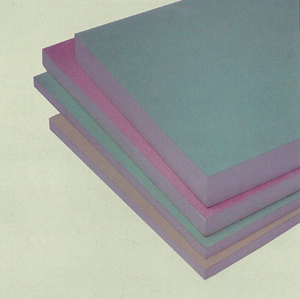
The gypsum boards have been installed as firewalls and acoustical barriers in many five-star hotels, mass rapid transit stations, office buildings, public work projects and luxury apartments in Taiwan.
Recycled Tiles
White Horse Ceramic Co., Ltd. is another certified green material supplier whose tiles are made of recycled materials and coated with nanometer-grade substance. Using recycled materials help minimize eco-damage from mining virgin minerals, while the nano-coating reduces adhesion index to enable easier cleaning of dirt, hence eliminating the need for water to clean high-rise walls.
